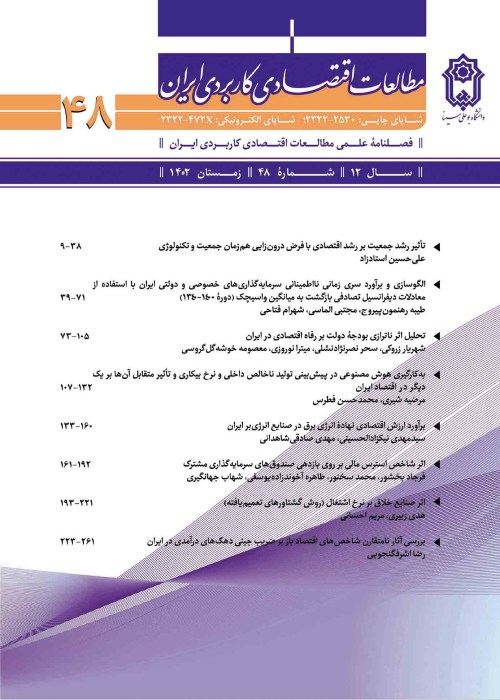The Return to Education in IRAN by Using Age Cohorts and Pseudo Panel Data Approach
Author(s):
Abstract:
Education as an effective social phenomenon has an important role in the realization of the cultural, social, political and economic objectives.The important role of education in individual and social behavior and its effect on economic growth and development process led to a new branch in economics as economics of education. Now the question for society is how education can affect their income increasing process, and how much should be policymakers invested in education? Given the importance of education on earnings, numerous studies have been performed in estimating the returns to education. In traditional approach, Mincer's earning function were used for estimating return of education. Mincer provided an earning function as a semi Logarithmic regression that dependent variable is income and independent variables are years of education and years of experience. The coefficient of years of schooling represents the average rate of return during training.
Using ordinary least squares (OLS) for estimation of returns to education in Mincer's earning function is unobserved heterogeneity among individuals. As a matter of fact, the main problem discussed in the literature on the returns to education is the endogeneity of the schooling variable. Individual choice of years of schooling is not exogenous and tends to be correlated with unobservables in the error term of the earnings function. The likely candidates for these unobservables are ability or motivation, which correlate with years of education and with earnings, giving rise to ability bias (Card, 1999). Given the expected positive correlations between ability and both earnings and years of schooling, the standard critique emphasizes an upward bias. To avoid inbreeding bias and individual unobserved heterogeneity, it is better to use panel data, but the main limitation is the lack of longitudinal data, especially in developing countries. As a result, it can be said that in studies which have been done in the field of returns to education, only a few of them have paid attention to the problem of estimation bias. Deaton (1985) used the cohort to solve the problem and suggested pseudo panel data. Each cohort is a group with specific members. Pseudo panel date is following the people's age group in a higher level than Cross-sectional data. The age groups have been made from repeated cross-sectional data from household surveys according to a group of people with specific characteristics.
In this study, we employ the pseudo-panel approach for estimating returns to education in Iran. Pseudo-panel data are constructed from repeated cross sections of Household Expenditure and Income Survey (HEIS) conducted by Statistical Center of Iran during 1991to 2012. The subjects were employee who was born between the years 1937 to 1981. In this study, 22 the period and 9 age group is used to form the cohort. Each cohort has been divided in 5-year period. For example, the ninth age group are 54-50 that are born between 1937-1941.
On the base of results, education has a positive and significant impact on earnings. The relatively high rate of educational return shows that investment in education is economically feasible; therefore, policy makers should pay more attention to its development. Also, the mens educational return is more than womens. On the other hand, the relation between age/ experience and income is inverse U. This means that with age / experience of the income increases. But, after reaching the maximum point, it do not expected more age / years of experience lead to an increase in income.
Using ordinary least squares (OLS) for estimation of returns to education in Mincer's earning function is unobserved heterogeneity among individuals. As a matter of fact, the main problem discussed in the literature on the returns to education is the endogeneity of the schooling variable. Individual choice of years of schooling is not exogenous and tends to be correlated with unobservables in the error term of the earnings function. The likely candidates for these unobservables are ability or motivation, which correlate with years of education and with earnings, giving rise to ability bias (Card, 1999). Given the expected positive correlations between ability and both earnings and years of schooling, the standard critique emphasizes an upward bias. To avoid inbreeding bias and individual unobserved heterogeneity, it is better to use panel data, but the main limitation is the lack of longitudinal data, especially in developing countries. As a result, it can be said that in studies which have been done in the field of returns to education, only a few of them have paid attention to the problem of estimation bias. Deaton (1985) used the cohort to solve the problem and suggested pseudo panel data. Each cohort is a group with specific members. Pseudo panel date is following the people's age group in a higher level than Cross-sectional data. The age groups have been made from repeated cross-sectional data from household surveys according to a group of people with specific characteristics.
In this study, we employ the pseudo-panel approach for estimating returns to education in Iran. Pseudo-panel data are constructed from repeated cross sections of Household Expenditure and Income Survey (HEIS) conducted by Statistical Center of Iran during 1991to 2012. The subjects were employee who was born between the years 1937 to 1981. In this study, 22 the period and 9 age group is used to form the cohort. Each cohort has been divided in 5-year period. For example, the ninth age group are 54-50 that are born between 1937-1941.
On the base of results, education has a positive and significant impact on earnings. The relatively high rate of educational return shows that investment in education is economically feasible; therefore, policy makers should pay more attention to its development. Also, the mens educational return is more than womens. On the other hand, the relation between age/ experience and income is inverse U. This means that with age / experience of the income increases. But, after reaching the maximum point, it do not expected more age / years of experience lead to an increase in income.
Keywords:
Language:
Persian
Published:
Quarterly Journal of Applied Economics Studiesin Iran, Volume:6 Issue: 22, 2017
Pages:
145 to 170
magiran.com/p1720361
دانلود و مطالعه متن این مقاله با یکی از روشهای زیر امکان پذیر است:
اشتراک شخصی
با عضویت و پرداخت آنلاین حق اشتراک یکساله به مبلغ 1,390,000ريال میتوانید 70 عنوان مطلب دانلود کنید!
اشتراک سازمانی
به کتابخانه دانشگاه یا محل کار خود پیشنهاد کنید تا اشتراک سازمانی این پایگاه را برای دسترسی نامحدود همه کاربران به متن مطالب تهیه نمایند!
توجه!
- حق عضویت دریافتی صرف حمایت از نشریات عضو و نگهداری، تکمیل و توسعه مگیران میشود.
- پرداخت حق اشتراک و دانلود مقالات اجازه بازنشر آن در سایر رسانههای چاپی و دیجیتال را به کاربر نمیدهد.
In order to view content subscription is required
Personal subscription
Subscribe magiran.com for 70 € euros via PayPal and download 70 articles during a year.
Organization subscription
Please contact us to subscribe your university or library for unlimited access!



